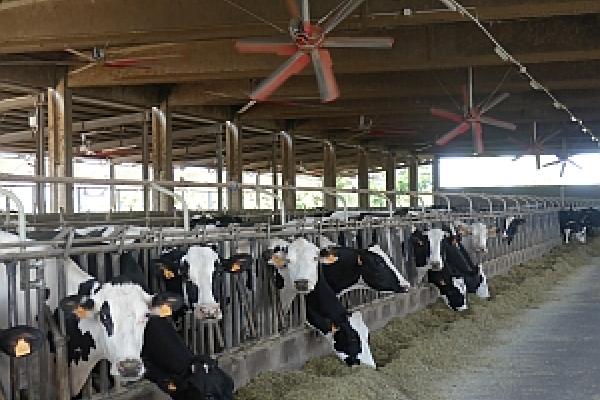Integrated Environment Management System in dairy barns to improve the welfare and productivity of the cows

The project aims to create a management system for the housing environment in the dairy farm by integrating the various information (microclimatic, non-climatic, behavioral, production, food, management) in order to provide: elements for the automatic control of some devices, signaling to the breeder of anomalous situations or requiring his intervention, monitoring of environmental parameters inside the barn, indications for a better management and to improve environmental conditions.
The project will develop a system for the collection of numerous parameters from the farm through automatic recording systems and adequate software for processing of the data collected.
The activity plan provides for the development, construction and installation of a prototype of an integrated management system for the environment in the dairy barns.
The technology to be developed is a system of continuous monitoring of the environmental parameters and of the behavior of the cows and of direct and indirect control of the barn environment, in order to create an environment suitable for life, production and the reproduction of cows reared in the facility, also mitigating the internal climate.
The rearing of the dairy cow has greatly evolved in recent years with the acquisition of new knowledge and the development of innovative technologies, with particular attention to animal welfare and comfort. The ability to keep dairy farms competitive in the international milk and raw materials market is largely due to the ability to achieve high standards of efficiency and quality in the various stages of the production process that takes place in the barn.
A factor limiting the efficiency of the production process in the barn concerns animal welfare which is related to the state of health of the animals themselves and influences the quantity and quality of their productions. Breeders often do not have adequate tools to evaluate the adequacy of the structures and management of the barn in an objective way and to identify the critical points and interventions that can improve the situation in an integrated way. These limits require not only a widespread and intense information, dissemination and training activity, but also the availability of innovative systems able to provide precise indications and, when possible, directly control the conditions of the environment inside the stable.
Therefore, monitoring the living environment and the health state of cows is gaining attention for several reasons. First, these parameters show promising correlation with the cows’ milk productivity, which is a primary economic driver for livestock raising. Then, there are raising ethical concerns about the environmental and life conditions of livestock animals. Finally, there is the possibility to build models to enable a better understanding of several pathologies.
Via Giovanni Celoria, 2
20133 Milano MI
Italy
Cascina Concordia n° 1
26010 Camisano CR
Italy
Via Molino 32A
26010 Casalletto Vaprio CR
Italy
Cascina Vidoretto
26019 Vailate CR
Italy
Via Kennedy, 30
26013 Crema CR
Italy
The technology to be developed is a system of continuous monitoring of the environmental parameters and of the behavior of the cows and of direct and indirect control of the stable environment, in order to create an environment suitable for the life, production and reproduction of the cows. cows raised in the structure also mitigating the internal climate.
The integrated system involves the use of different sensors that allow to detect:
- the temperature, humidity and air speed in different points of the barn
- the quality of the air in the farm by detecting the following parameters: ammonia (NH3), hydrogen sulphide (H2S), carbon dioxide (CO2), methane (CH4), noise
- monitoring the behavior of the cows, automatically detecting the time spent in the various activities (standing, feeding, resting) by means of accelerometers and presence sensors in the different areas of the barn
- monitoring of the presence of insects in the stable (photo of traps and image analysis)
- monitoring of water consumption and water temperature in drinkers
- monitoring of the functioning of manure removal systems
The sensors send the data to a centralized storage and processing system of the collected data in order to provide useful information for the management of the barn.
The integration of the various information obtained from the sensors positioned in the barn and on the animals will be carried out by implementing specific methods of analysis and evaluation of the data transmitted wirelessly by the sensors to the control units which in turn will communicate with a central system through a radio connection and subsequently will be sent to a Cloud archive.
The data that will be collected automatically can be divided into three main categories:
- information relating to the monitoring of the relaying area (microclimate, presence of insects, temperature and drinking water consumption, air quality, etc.)
- information on the behavior and condition of the cows;
- information on the position of the cows in the barn
The software that will be developed will use the data to transform them into useful information for the management of the stable and directly usable by the farmer.
| Titolo/Descrizione | Url | Tipologia |
|---|---|---|
|
pagina web del progetto
|
Link ad altri siti che ospitano informazioni del progetto
|
|
|
Video del progetto
|
Link ad altri siti che ospitano informazioni del progetto
|
|
|
filmato accelerometri
|
Link ad altri siti che ospitano informazioni del progetto
|
|
|
Brochure informativa del progetto
|
Materiali utili
|
|
|
Scheda tecnica del sistema integrato
|
Materiali utili
|
|
|
Pubblicazione scientifica sugli indicatori per il benessere animale
|
Materiali utili
|
|
|
Pubblicazione scientifica sullo sviluppo degli accelerometri
|
Materiali utili
|
|
|
Installazione dei prototipi nelle tre aziende
|
Materiali utili
|
|
|
Report del progetto GALA
|
Materiali utili
|
